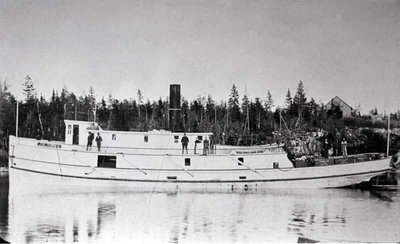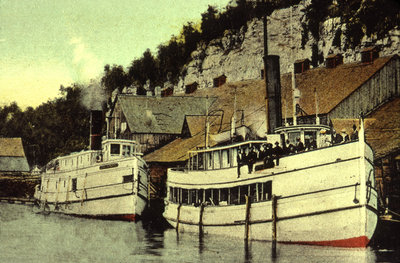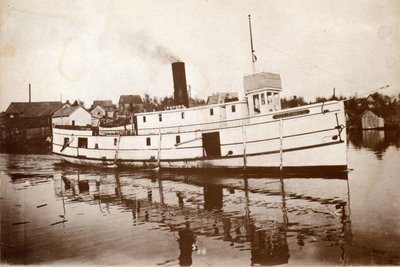Table of Contents
Those who devote themselves to the study of mysterious shipwrecks on the Great Lakes, together with those who are interested in the ships of the Georgian Bay area, will all be familiar with the small wooden steamer J. H. JONES, but we are certain that there are a great number of T.M.H.S. members who have never heard of her, or who may recognize the name without being able to recall her story. It is now eighty years since this gallant little steamer succumbed to the vagaries of Georgian Bay weather, and the time would seem to be ripe for us to tell what we have been able to find out about her.
J. H. JONES was a small, wooden-hulled, combination passenger and freight steamer which was built in 1888 at Goderich, Ontario, by one William Marl-ton. She was enrolled at Goderich as C.90769, and her hull was recorded as being 107.0 feet in length, 21.4 feet in the beam, and 10.0 feet in depth. Her original Gross Tonnage was variously reported as having been 208 or 191, although by 1895 her tonnage was recorded as 152 Gross and 98 Net, and her depth as being 9.5 feet. We have no information concerning the machinery that was fitted in her, and we would be obliged if any of our members could enlighten us in this regard.

Early photo is believed to show J. H. JONES in her original state, as built in 1888. Note freight stowed aft. Photo courtesy Ronald F. Beaupre.
The "Wiarton Echo" of Friday, May 4th, 1888, reported that her first owners were McKay and Clark, and that she was built to operate from Wiarton to Tobermory (at the tip of the Saugeen or Bruce Peninsula) and to South Bay (on Manitoulin Island), superceding the "JAS. CLARK" (JAMES CLARKE? - Ed.), which had been owned by Porter and McLeod. In 1892, she was owned by James Clark of Goderich, and she was classed as a "fish tug". The 1892 "Inland Lloyds" vessel register indicated that a new engine had been fitted in the JONES during 1891. Clark was still her owner in 1895, according to the Dominion register, and there are indications that the vessel was rebuilt during the 1895 season. (It should also be borne in mind that early records, whether "official" or not, often contain discrepancies in respect of the spelling of names, both of ships and of their owners.)
J. H. JONES was a vessel that was somewhat peculiar in appearance by today's standards, but was typical of ships of her type in her era. She had a beautiful hull, with a straight stem, a graceful counter stern, and a marked sheer. The main deck area was enclosed from the stem all the way back for about three-quarters of the steamer's length, while her fantail area was open and protected only by a closed rail. The main deck cabin was fitted with large gangways for the handling of cargo, and much freight was carried out on the open fantail.
The upper deck was provided with a closed rail forward, but this gave way to an open rail which began at a point about opposite the pilothouse. A fairly short cabin provided accommodation for the crew and any passengers, and at its forward end was the small, squarish pilothouse, which sported two large, sectioned windows in its front. A raked stack, substantial but rather short, rose out of the upper deck cabin near its after end. Two lifeboats were carried well aft on the upper deck, abaft the cabin.
As long as she looked like this, J. H. JONES was a rather handsome vessel, somewhat resembling some of the famous salvage tugs of the day. Sometime later, however, and perhaps in 1895, "the JONES was rebuilt aft, and the reconstruction certainly did not improve her appearance. The main deck cabin was extended all the way aft, and large gangways were fitted in this new section of the superstructure. The extended upper deck atop this cabin looked odd in that the open rail was not extended all the way to the fantail as might have been expected, but rather changed once again to a closed rail in the new sec tion. The upper deck cabin was never extended aft, and the new section of the deck remained open, with large quantities of cargo, including crates of fish, often being stacked there.
Another feature that detracted somewhat from the JONES' original racy appearance was the inordinately high weathercloth which she often sported, in later years, around the open bridge atop the pilothouse. This dodger gave the steamer a somewhat "top-heavy" look, but its presence was undoubtedly appreciated by any officers who stood watch on the monkey's island, where they were exposed to all of the elements.
During the latter part of the 1898 season, there occurred an event which very nearly brought the career of the JONES to an untimely end. She was run down and sunk by the much larger passenger and freight propellor [sic] PACIFIC, of the Great Northern Transit Company, Collingwood. The JONES was. the loser in the encounter, but she survived to operate for several additional seasons, whereas PACIFIC was the victim of a fire later the same year. PACIFIC had been built at Owen Sound in 1883, and was 179.0 x 31.0 x 11.0, 918 Gross and 524 Net. On November 3rd, 1898, the Grand Trunk Railway shed at Collingwood caught fire, and the flames spread to PACIFIC, which was moored next to the shed. The only part of PACIFIC to survive the blaze was her engine, which originally served in the EMERALD, (a) OSWEGO BELLE (80), which had been dismantled in 1882. After the fire which destroyed PACIFIC, the engine was placed in the new steamer GERMANIC, which was completed at Collingwood in 1899.
Returning now to the collision between the JONES and the PACIFIC, we find details of the accident in the Thursday, September 22, 1898 issue of the "Wiarton Echo", which reported that J. H. JONES sank in nine minutes following the accident, but that all of her passengers and crew were saved. The JONES had sailed from Wiarton on the morning of Friday, September l6th, bound for the local fishing islands and laden with a full cargo of merchandise and supplies for the different fishing stations which operated under the supervision of the Buffalo Fish Company. Also on board was a substantial amount of money, of which $1,500 belonged to the Buffalo Fish Company, $1,000 belonged to J.H. Fielding and was entrusted to Capt. MacAulay for William Irwin to buy sheep, and $500 was being sent by C. V. Parke to the island for the purpose of purchasing cattle.
The "Wiarton Echo" report continues. "It appears that at 12:05 Friday night (more properly 12:05 a.m. on Saturday, September 17, 1898 - Ed.), when three miles from Kagawong (in the North Channel, on the shore of Manitoulin Island) just as the watches were being changed, Dobson, the mate, coming off and Capt. Angus MacAulay going on, the lights of the PACIFIC hove in sight. Sinclair, who wheels the captain's watch, had gone below for something and the captain took the wheel.
"He saw the PACIFIC coming straight for him, giving whistles that she wanted to pass on the starboard side. This (signal) the JONES answered, but on coming closer to the approaching boat, Capt. MacAulay found that to take the starboard side would crowd him too close to the shore. He whistled to take the port side and turned the boat that way, but finding he was too close to the PACIFIC to get clear, he gave bells to stop and back up, but before the engines were reversed, the PACIFIC struck the JONES on the port bow just forward of the gangway, driving a hole in her of considerable size, and she began to sink at once. The collision brought the PACIFIC right alongside the JONES and the passengers and crew immediately jumped aboard of her, as the injured boat was going down rapidly.

J.H. JONES and JOE MILTON at the Dominion Fish Company at Wiarton.
"After everyone was supposed to be safely off, it was found that Mrs. Young, a 70-year-old lady from Tobermory, was missing. Two or three of the crew again jumped aboard of the sinking craft, broke open her door, and found her sleeping as peacefully as a babe. They carried her out and into the PACIFIC in her night clothes.
"It was then remembered that in a drawer in a small desk of the captain's, there was considerable money amounting to upwards of $1,500. Wheelsman Robert Sinclair jumped on the JONES and secured it. The captain got his trunk off, in which there were his clothing and some valuables, but in the hurry, the $1,000 belonging to Mr. Fielding and the $500 belonging to Mr. C. V. Parke, which was under Captain MacAulay's pillow, was overlooked and went down with the boat.
"When the captain got his trunk off, the stern of the boat was well under water, but the bow stood up pretty well, owing evidently to the large number of fish packages and empty fish cans which would contain considerable air.
"The PACIFIC lay alongside for a few minutes after all were safe on board, then continued on her trip up. The lights of the JONES could be seen for some time by the passengers of the PACIFIC, after she was abandoned. It is calculated that she floated about nine minutes. After a short run up, the CITY OF MIDLAND was met, and the passengers and crew of the JONES were transferred, except the captain and the mate, who went on to Gore Bay, chartered a tug, and went back to where the boat was sunk, and are still there.
"The JONES was insured for $7,000 and it is quite probable that the insurance company will raise her, as she was located on Tuesday (September 20) in about forty feet of water, so the raising of her will not be a very heavy or expensive undertaking.
"As soon as Mr. J. MacAulay learned of the accident, he at once ordered the steamer JOHN J. LONG, of Collingwood, to be fitted out to take the route, and the JOE MILTON was chartered to take up supplies and bring down fish. She arrived down on Tuesday with a cargo of fish. The McINTOSH is also on the route, bringing down fish to keep the market supplied.
"The raising of the JONES will commence at once, and it is thought that within a month, she will be on the route again."
The "Wiarton Echo" of Thursday, October 20, 1898, reported that "on Monday, the steamer J. H. JONES was raised, and will be in Owen Sound dry dock Saturday if the weather permits. The injuries done to her in the collision are of much greater extent than was at first believed." The same newspaper reported on Thursday, October 27th, that the JONES was lying in Kagawong harbour, ready to go to drydock when the weather might permit. The issue of Thursday, November 3rd, commented that "the steamer J. H. JONES, which was sunk on September l6th by collision with the steamer PACIFIC near Kagawong, was taken to Owen Sound on Monday, and is now in the dry dock there, where she will be repaired."
No doubt the repairs to J. H. JONES were put in hand quickly once she was on the dock at Owen Sound. We do not know how long the work took, but it would seem unlikely that the JONES was back in service before the close of navigation for the 1898 season. She was, however, back on her old route in 1899. In 1900, J. H. JONES was sold to the Crawford Tug Company, Wiarton, which was operated by Captain James Crawford and his brothers, John and Middleton. It is reported that the steamer was rebuilt in 1901 by the Polson Iron Works Ltd. at Owen Sound, although we suspect that this reconstruction was simply a renewal of any deteriortaed [sic] sections of the hull as opposed to a structural alteration.
The JONES was still being operated by the Crawfords, in much the same trade as before, when she finally came to her tragic end. Perhaps it was that the fate she cheated at the time of her collision with PACIFIC finally caught up with her. In any event, neither the JONES nor any of the persons aboard her would escape when the end finally came.

Her stern rebuilt, J. H. JONES looked like this at the time of her loss in 1906. Photo courtesy Ronald F. Beaupre.
It was at 10:00 a.m. on Thursday, November 22nd, 1906, that J. H. JONES departed from Owen Sound with a full load of freight and seventeen passengers, en route to Lion's Head and Tobermory on her regular run for the collection of fish in boxes from the various fishing stations. The weather, as might have been anticipated that late in the season, was inclement, and heavy seas were being stirred up on the open sections of Georgian Bay. The steamer passed Cape Croker Light, some 27 1/2 miles out of Owen Sound, at about 1:30 p.m., her passage observed by lightkeeper Richard Chapman, who noted that she was having a difficult time of it in the heavy seas.
The J. H. JONES then disappeared from Chapman's view, and to this day has never again been seen. It is thought that she foundered somewhere off Cove of Cork Bay, which is a large bight located between Cape Croker and Montresor Point, and the area to which the steamer had fought her way before the lightkeeper lost sight of her. All on board perished, including Capt. James Crawford, 51, and only one body was ever found, that being a crew member who later washed ashore on the east side of Christian Island. One week after the sinking, the cabin of the JONES also washed up on the shore of Christian Island. It is said that a barrel of oil that washed up into Cove of Cork Bay during a storm in 1917 was from the JONES, but we know of no positive identification in this respect. To this day, the location of the wreck has remained a mystery, in spite of the considerable underwater exploration that has been done in the region.
The "Wiarton Echo" of Thursday, November 29, 1906, printed a list of a total of thirty passengers and crew who were believed to have been lost in the sinking. The crew were Capt. James Crawford, master; Edward Lennox, first mate; George Smith, second mate; Charles Shaw, first engineer; Wesley Sadler, second engineer; George McEwen, wheelsman; William Ross, wheelsman; - McVittie, fireman; Thomas Simmons (or R. S. Simmonds), fireman; James Tilley, deckhand; - Spears, deckhand; Frank Jackson, cook; and Mervin Clark, cook. All but Sadler, McVittie and Spears were immediately confirmed to have been from Wiarton.
The passengers who lost their lives on that last trip of J. H. JONES were Louis Allan, Owen Sound; Mr. and Mrs. Burley and their three children, Shallow Lake; J. T. Donaldson, manager of the Wolverine Fish Company, Owen Sound; Frank Fellon and George Fellon, Tobermory; James Fox, Southampton; Alex Lyons and Mrs. Lyons, Owen Sound; Daniel McIvor, Providence Bay; T. M. Wagg, Manitoulin Island, "and three men being sent by Capt. Graham to Silverwater".
J. H. JONES put in the better part of two decades of service in the trade for which she was built, operating reliably and apparently to the satisfaction of her various owners and those who employed her services. Unfortunately, however, she is not remembered for those good years. Instead, she is recalled (when at all) for the tragic circumstances of her loss. That she succumbed to the late-season weather on Georgian Bay is not surprising, for that beautiful but dangerous body of water has, over the years, claimed much larger and stronger vessels than the JONES.
Ed. Note; For his assistance in doing considerable Wiarton-area research for this feature, we are greatly indebted to member Ronald F. Beaupre of Port Elgin. Ron also managed to unearth the two photos of J. H. JONES which accompany the article, and they are undoubtedly the best views of the steamer that we have ever seen.
Previous Next
Return to Home Port or Toronto Marine Historical Society's Scanner
Reproduced for the Web with the permission of the Toronto Marine Historical Society.